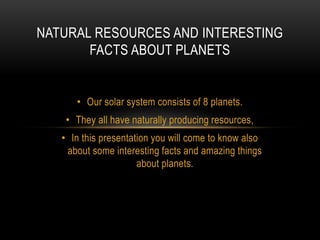amazing facts and natural resources of planets
•Download as PPTX, PDF•
2 likes•885 views
so much to know
Report
Share
Report
Share

Recommended
More Related Content
What's hot
What's hot (17)
Similar to amazing facts and natural resources of planets
Similar to amazing facts and natural resources of planets (20)
Earth and Space year 5 project Earth, Planets, Space and Sun

Earth and Space year 5 project Earth, Planets, Space and Sun
Recently uploaded
Recently uploaded (20)
Seismic Method Estimate velocity from seismic data.pptx

Seismic Method Estimate velocity from seismic data.pptx
Forensic Biology & Its biological significance.pdf

Forensic Biology & Its biological significance.pdf
Hire 💕 9907093804 Hooghly Call Girls Service Call Girls Agency

Hire 💕 9907093804 Hooghly Call Girls Service Call Girls Agency
Asymmetry in the atmosphere of the ultra-hot Jupiter WASP-76 b

Asymmetry in the atmosphere of the ultra-hot Jupiter WASP-76 b
Pests of mustard_Identification_Management_Dr.UPR.pdf

Pests of mustard_Identification_Management_Dr.UPR.pdf
Disentangling the origin of chemical differences using GHOST

Disentangling the origin of chemical differences using GHOST
VIRUSES structure and classification ppt by Dr.Prince C P

VIRUSES structure and classification ppt by Dr.Prince C P
PossibleEoarcheanRecordsoftheGeomagneticFieldPreservedintheIsuaSupracrustalBe...

PossibleEoarcheanRecordsoftheGeomagneticFieldPreservedintheIsuaSupracrustalBe...
SAMASTIPUR CALL GIRL 7857803690 LOW PRICE ESCORT SERVICE

SAMASTIPUR CALL GIRL 7857803690 LOW PRICE ESCORT SERVICE
Stunning ➥8448380779▻ Call Girls In Panchshil Enclave Delhi NCR

Stunning ➥8448380779▻ Call Girls In Panchshil Enclave Delhi NCR
Formation of low mass protostars and their circumstellar disks

Formation of low mass protostars and their circumstellar disks
Biopesticide (2).pptx .This slides helps to know the different types of biop...

Biopesticide (2).pptx .This slides helps to know the different types of biop...
❤Jammu Kashmir Call Girls 8617697112 Personal Whatsapp Number 💦✅.

❤Jammu Kashmir Call Girls 8617697112 Personal Whatsapp Number 💦✅.
Labelling Requirements and Label Claims for Dietary Supplements and Recommend...

Labelling Requirements and Label Claims for Dietary Supplements and Recommend...
amazing facts and natural resources of planets
- 1. • Our solar system consists of 8 planets. • They all have naturally producing resources, • In this presentation you will come to know also about some interesting facts and amazing things about planets. NATURAL RESOURCES AND INTERESTING FACTS ABOUT PLANETS
- 2. SOLAR SYSTEM THERE ARE EIGHT PLANETS IN THE SOLAR SYSTEM, WHICH ARE IN INCREASING DISTANCE FROM THE SUN: • Mercury. • Venus. • Earth. • Mars. • Jupiter. • Saturn. • Uranus. • Neptune.
- 3. Amazing facts: • A year on Mercury is just 88 days long. • Mercury is the smallest planet in the Solar System. • Mercury is the second densest planet. • Mercury has wrinkles. • Mercury has a molten core. Mercury: 1. volcanoes 2. forest fires 3. canna bar 4. (ore) and 5. Fossil fuels such as coal and 6. petroleum. Natural resources:
- 4. Venus: Natural resources: mountains, which form its landscape, apparently consist of metal, and appear to be gigantic natural resources plant.
- 5. Earth: Natural resources: 1. Air, water and soil. 2. Biological resources - plants and animals. 3. Raw materials (like minerals) 4. Space and land. 5. Wind, geothermal, tidal and solar energy.
- 6. Amazing facts: Mars is the fourth planet from the Sun and is the second smallest planet in the solar system. Named after the Roman god of war, Mars is also often described as the “Red Planet” due to its reddish appearance. Mars: Natural resources: Traces of aluminum, titanium, chr omium, gold, and other metals have been found in meteorites believed to have originated from Mars
- 7. Jupiter: Natural resources: 1. Development Review (commercial and residential) 2. Habitat protection (uplands, wetlands) 3. Wildlife protection (eagles, sea turtles, osprey, tortoise) 4. Vegetation protection (upland and wetland vegetation)
- 8. Saturn: Natural resources: Trace amounts of ammonia, acetylene, eth ane, propane, phosphine and methane have been detected in Saturn's atmosphere.
- 9. Uranus: Natural resources: Uranus, with no solid surface, is one of the gas giant planets. Its atmosphere is composed primarily of hydrogen Uranus gets its blue-green color from methane gas. Amazing facts: Uranus turns on its axis once every 17 hours, 14 minutes. Uranus makes one trip around the Sun every 84 Earth years. Uranus is often referred to as an “ice giant” planet. Uranus hits the coldest temperatures of any planet.
- 10. Neptune: Natural resources: Despite being smaller than Uranus, Neptune has a greater mass. Below its heavy atmosphere, Uranus is made of layers of hydrogen, helium, and methane gases. They enclose a layer of water, ammonia and methane ice.
- 11. COMPOSITION OF CORES: Mars: Neptune: Uranus:
- 12. Made by suleman khan